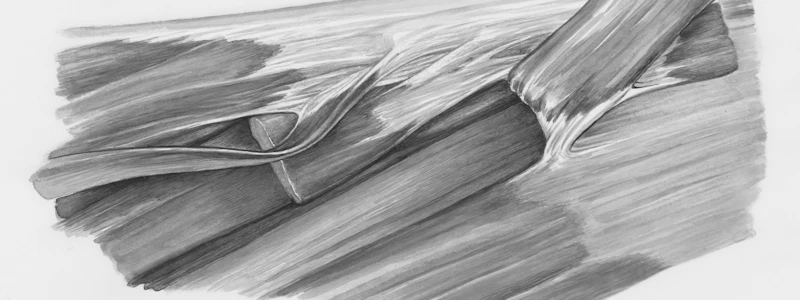Podcast
Questions and Answers
Cells that have absorbed melanin to distribute pigmentation to other cells are located in what layer of the skin?
Cells that have absorbed melanin to distribute pigmentation to other cells are located in what layer of the skin?
- stratum granulosum
- stratum lucidum
- stratum corneum
- stratum spinosum (correct)
The greatest concentration of sudoriferous glands is found on the:
The greatest concentration of sudoriferous glands is found on the:
- eyelids
- arms
- palms, soles, scalp and forehead, and underarms (correct)
- midsection of the body
What is the function of sebum?
What is the function of sebum?
- mix with sweat to form the acid mantle (correct)
- produce sweat
- give skin elasticity
- carry melanin
The stratum corneum is composed of:
The stratum corneum is composed of:
Dry skin is usually characterized as:
Dry skin is usually characterized as:
In which layer of the skin do the cells become irregularly shaped and have a spiny appearance?
In which layer of the skin do the cells become irregularly shaped and have a spiny appearance?
The sebaceous gland produces:
The sebaceous gland produces:
Which layer of the skin acts as a protective cushion to protect the bones and gives the body its contour and shape?
Which layer of the skin acts as a protective cushion to protect the bones and gives the body its contour and shape?
The small openings onto the skin from the sudoriferous glands are called:
The small openings onto the skin from the sudoriferous glands are called:
Sudoriferous glands, sebaceous glands, sensory nerve endings, arrector pili muscles and a major portion of each hair follicle are found in the:
Sudoriferous glands, sebaceous glands, sensory nerve endings, arrector pili muscles and a major portion of each hair follicle are found in the:
The sudoriferous glands are referred to as:
The sudoriferous glands are referred to as:
Which of the following structures is found in the stratum lucidum layer?
Which of the following structures is found in the stratum lucidum layer?
The layer of the epidermis that is shed and replaced constantly is the:
The layer of the epidermis that is shed and replaced constantly is the:
The stratum lucidum layer is found only on the:
The stratum lucidum layer is found only on the:
What is another name for the stratum germinativum?
What is another name for the stratum germinativum?
What quality is notable about the stratum corneum?
What quality is notable about the stratum corneum?
Which layer of the epidermis protects the skin's moisture balance by acting as a barrier to moisture loss?
Which layer of the epidermis protects the skin's moisture balance by acting as a barrier to moisture loss?
The excretion of sweat from the skin is controlled by the:
The excretion of sweat from the skin is controlled by the:
Which type of skin is NOT prone to acne?
Which type of skin is NOT prone to acne?
Where does mitosis or cell division of the skin take place?
Where does mitosis or cell division of the skin take place?
Which of the following lesions are like vesicles, but larger and occur in cases of second-degree burns?
Which of the following lesions are like vesicles, but larger and occur in cases of second-degree burns?
A highly contagious bacterial infection that produces a honey-yellow, crusted lesion that is usually found on the face is known as?
A highly contagious bacterial infection that produces a honey-yellow, crusted lesion that is usually found on the face is known as?
Where does a steatoma usually appear?
Where does a steatoma usually appear?
Flashcards are hidden until you start studying
Study Notes
Skin Anatomy and Functions
- Melanin-absorbing cells for pigmentation exist in the stratum spinosum.
- The highest concentration of sudoriferous glands found on palms, soles, scalp, forehead, and underarms.
- Sebum functions to mix with sweat and form the acid mantle, protecting the skin.
- The stratum corneum is primarily composed of keratin cells, providing a protective barrier.
- Dry skin is characterized by not being prone to acne due to its lack of excess oil.
Skin Layers
- Cells in the stratum spinosum exhibit a spiny appearance and become irregularly shaped.
- Sebaceous glands are responsible for producing sebum (oil) for skin lubrication.
- The protective cushioning layer is the subcutaneous layer, giving body's shape and contour.
- Pores are small openings on the skin associated with sudoriferous glands.
- The reticular layer houses sudoriferous and sebaceous glands, sensory nerve endings, and arrector pili muscles.
Layer Specifics
- Sudoriferous glands are identified as duct glands due to their structure.
- Squamous cells reside in the stratum lucidum, which is found only on soles and palms.
- The constantly shedding layer of the epidermis is the stratum corneum.
- The stratum basale is synonymous with stratum germinativum where cell division occurs.
Skin Health and Conditions
- The stratum corneum is considered the toughest layer of the skin, providing resilience.
- To maintain moisture balance, the stratum corneum serves as a barrier against moisture loss.
- Control of sweat excretion is managed by the nervous system.
- Dry skin is the skin type least prone to acne, unlike oily or combination skin.
Skin Lesions and Infections
- Bulla are lesions larger than vesicles, commonly seen in second-degree burns.
- Impetigo is a highly contagious bacterial infection characterized by honey-yellow crusted lesions primarily on the face.
- Steatoma typically presents on the scalp, neck, or back, known for being a fatty tumor.
Mitosis and Skin Physiology
- The process of mitosis, or cell division, primarily takes place in the stratum basale.
Studying That Suits You
Use AI to generate personalized quizzes and flashcards to suit your learning preferences.




